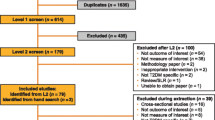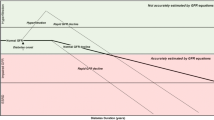Abstract
Background
A urinary biomarker sensitive to glomerular functional or structural changes in diabetic kidney disease is required. This study examined whether urinary C-megalin reflects renal function or albuminuria in diabetes.
Methods
This was a cross-sectional study involving 1576 patients with type 1 or 2 diabetes. The exposure variables were estimated glomerular filtration rate (eGFR) and urinary albumin-to-creatinine ratio (UACR), and the outcomes were urinary C-megalin excretion and concentration. Two-part models were used to examine the associations between eGFR and UACR with urinary C-megalin excretion or concentration.
Results
The UACR was linearly associated with urinary C-megalin excretion (per 100 mg/gCr of UACR; 11.8 fM/gCr [95% CI 8.9–14.7]). There was no association between decreasing eGFR and increasing urinary C-megalin excretion. The UACR was also linearly associated with the urinary C-megalin concentration (per 100 mg/gCr of UACR, 7.7 fM/L [95% CI 5.8–9.6]). At eGFR values > 60 mL/min/1.73 m2, the eGFR and urinary C-megalin concentration were inversely linearly related (per 10 mL/min/1.73 m2 decline, 7.7 fM/L [95% CI 0.2–15.1]).
Conclusion
Urinary C-megalin excretion as well as concentration levels are potentially useful biomarkers to detect early changes in diabetic kidney disease.



Similar content being viewed by others
Data availability
The datasets analyzed during the current study are available from the corresponding author on reasonable request.
Code availability
The statistical codes generated during the current study are not publicly available due to subsequent use for ongoing research project but are available from the corresponding author on reasonable request.
References
Persson F, Rossing P (2018) Diagnosis of diabetic kidney disease: state of the art and future perspective. Kidney Int Suppl 8(1):2–7. https://doi.org/10.1016/j.kisu.2017.10.003
Yamanouchi S, Kimata T, Kino J, Kitao T, Suruda C, Tsuji S, Kurosawa H, Hirayama Y, Saito A, Kaneko K (2017) Urinary C-megalin for screening of renal scarring in children after febrile urinary tract infection. Pediatr Res 83(3):662–668. https://doi.org/10.1038/pr.2017.276
Ogasawara S, Hosojima M, Kaseda R, Kabasawa H, Yamamoto-Kabasawa K, Kurosawa H, Sato H, Iino N, Takeda T, Suzuki Y, Narita I, Yamagata K, Tomino Y, Gejyo F, Hirayama Y, Sekine S, Saito A (2012) Significance of urinary full-length and ectodomain forms of megalin in patients with type 2 diabetes. Diabetes Care 35(5):1112–1118. https://doi.org/10.2337/dc11-1684
Nielsen R, Christensen EI, Birn H (2016) Megalin and cubilin in proximal tubule protein reabsorption: from experimental models to human disease. Kidney Int 89(1):58–67. https://doi.org/10.1016/j.kint.2015.11.007
Yokoyama H, Sone H, Oishi M, Kawai K, Fukumoto Y, Kobayashi M (2009) Prevalence of albuminuria and renal insufficiency and associated clinical factors in type 2 diabetes: the Japan Diabetes Clinical Data Management study (JDDM15). Nephrol Dial Transplant 24(4):1212–1219. https://doi.org/10.1093/ndt/gfn603
Tonneijck L, Muskiet MH, Smits MM, van Bommel EJ, Heerspink HJ, van Raalte DH, Joles JA (2017) Glomerular hyperfiltration in diabetes: mechanisms, clinical significance, and treatment. J Am Soc Nephrol 28(4):1023–1039. https://doi.org/10.1681/asn.2016060666
Umanath K, Lewis JB (2018) Update on diabetic nephropathy: core curriculum 2018. Am J Kidney Dis 71(6):884–895. https://doi.org/10.1053/j.ajkd.2017.10.026
Hayashino Y, Mashitani T, Tsujii S, Ishii H (2014) Serum high-sensitivity c-reactive protein levels are associated with high risk of development, not progression, of diabetic nephropathy among Japanese type 2 diabetic patients: a prospective cohort study (Diabetes Distress and Care Registry at Tenri [DDCRT7]). Diabetes Care. https://doi.org/10.2337/dc14-1357
Hayashino Y, Okamura S, Tsujii S, Ishii H (2018) Association between diabetes distress and all-cause mortality in Japanese individuals with type 2 diabetes: a prospective cohort study (Diabetes Distress and Care Registry in Tenri [DDCRT 18]). Diabetologia 61(9):1978–1984. https://doi.org/10.1007/s00125-018-4657-4
Incerti J, Zelmanovitz T, Camargo JL, Gross JL, de Azevedo MJ (2005) Evaluation of tests for microalbuminuria screening in patients with diabetes. Nephrol Dial Transplant 20(11):2402–2407. https://doi.org/10.1093/ndt/gfi074
Zelmanovitz T, Gross JL, Oliveira J, De Azevedo MJ (1998) Proteinuria is still useful for the screening and diagnosis of overt diabetic nephropathy. Diabetes Care 21(7):1076–1079. https://doi.org/10.2337/diacare.21.7.1076
Zelmanovitz T, Gross JL, Oliveira JR, Paggi A, Tatsch M, Azevedo MJ (1997) The receiver operating characteristics curve in the evaluation of a random urine specimen as a screening test for diabetic nephropathy. Diabetes Care 20(4):516–519. https://doi.org/10.2337/diacare.20.4.516
Molitch ME, DeFronzo RA, Franz MJ, Keane WF, Mogensen CE, Parving HH, Steffes MW, Association AD (2004) Nephropathy in diabetes. Diabetes Care 27(suppl 1):S79-83. https://doi.org/10.2337/diacare.27.2007.s79
Levey AS, Cattran D, Friedman A, Miller WG, Sedor J, Tuttle K, Kasiske B, Hostetter T (2009) Proteinuria as a surrogate outcome in CKD: report of a scientific workshop sponsored by the National Kidney Foundation and the US Food and Drug Administration. Am J Kidney Dis 54(2):205–226. https://doi.org/10.1053/j.ajkd.2009.04.029
Matsuo S, Imai E, Horio M, Yasuda Y, Tomita K, Nitta K, Yamagata K, Tomino Y, Yokoyama H, Hishida A, on behalf of the collaborators developing the Japanese equation for estimated GFR (2009) Revised equations for estimated GFR from serum creatinine in Japan. Am J Kidney Dis 53(6):982–992. https://doi.org/10.1053/j.ajkd.2008.12.034
Peruchetti DdB, Silva-Aguiar RP, Siqueira GM, Dias WB, Caruso-Neves C (2018) High glucose reduces megalin-mediated albumin endocytosis in renal proximal tubule cells through protein kinase B O-GlcNAcylation. J Biol Chem 293(29):11388–11400. https://doi.org/10.1074/jbc.RA117.001337
Deb P, Norton EC (2018) Modeling health care expenditures and use. Annu Rev Public Health 39(1):489–505. https://doi.org/10.1146/annurev-publhealth-040617-013517
Thrailkill KM, Nimmo T, Bunn RC, Cockrell GE, Moreau CS, Mackintosh S, Edmondson RD, Fowlkes JL (2009) Microalbuminuria in type 1 diabetes is associated with enhanced excretion of the endocytic multiligand receptors megalin and cubilin. Diabetes Care 32(7):1266–1268. https://doi.org/10.2337/dc09-0112
De S, Kuwahara S, Hosojima M, Ishikawa T, Kaseda R, Sarkar P, Yoshioka Y, Kabasawa H, Iida T, Goto S, Toba K, Higuchi Y, Suzuki Y, Hara M, Kurosawa H, Narita I, Hirayama Y, Ochiya T, Saito A (2017) Exocytosis-mediated urinary full-length megalin excretion is linked with the pathogenesis of diabetic nephropathy. Diabetes 66(5):1391–1404. https://doi.org/10.2337/db16-1031
Hammond GL (2017) Sex hormone-binding globulin and the metabolic syndrome. In: Winters SJ, Huhtaniemi IT (eds) Male hypogonadism: basic, clinical and therapeutic principles. Springer International Publishing, Cham, pp 305–324. https://doi.org/10.1007/978-3-319-53298-1_15
Kurosaki Y, Imoto A, Kawakami F, Yokoba M, Takenaka T, Ichikawa T, Katagiri M, Ishii N (2018) Oxidative stress increases megalin expression in the renal proximal tubules during the normoalbuminuric stage of diabetes mellitus. Am J Physiol Renal Physiol 314(3):F462–F470. https://doi.org/10.1152/ajprenal.00108.2017
Tanaka S, Sugiura Y, Saito H, Sugahara M, Higashijima Y, Yamaguchi J, Inagi R, Suematsu M, Nangaku M, Tanaka T (2018) Sodium–glucose cotransporter 2 inhibition normalizes glucose metabolism and suppresses oxidative stress in the kidneys of diabetic mice. Kidney Int 94(5):912–925. https://doi.org/10.1016/j.kint.2018.04.025
Guy M, Borzomato JK, Newall RG, Kalra PA, Price CP (2009) Protein and albumin-to-creatinine ratios in random urines accurately predict 24 h protein and albumin loss in patients with kidney disease. Ann Clin Biochem 46(Pt 6):468–476. https://doi.org/10.1258/acb.2009.009001
Mischak H, Ioannidis JPA, Argiles A, Attwood TK, Bongcam-Rudloff E, Broenstrup M, Charonis A, Chrousos GP, Delles C, Dominiczak A, Dylag T, Ehrich J, Egido J, Findeisen P, Jankowski J, Johnson RW, Julien BA, Lankisch T, Leung HY, Maahs D, Magni F, Manns MP, Manolis E, Mayer G, Navis G, Novak J, Ortiz A, Persson F, Peter K, Riese HH, Rossing P, Sattar N, Spasovski G, Thongboonkerd V, Vanholder R, Schanstra JP, Vlahou A (2012) Implementation of proteomic biomarkers: making it work. Eur J Clin Investig 42(9):1027–1036. https://doi.org/10.1111/j.1365-2362.2012.02674.x
Acknowledgements
We would especially like to thank Yukari Moritsuji, Yuki Fujita, Noriko Nakamura, and Yoko Sakamoto (Department of Endocrinology, Tenri Hospital) for clerical support. Members of the Diabetes Distress and Care Registry at Tenri Study Group: Hitoshi Ishii, and Hirohito Kuwata (Department of Diabetology, Nara Medical University); Satoru Tsujii, Shintaro Okamura, Yasuaki Hayashino, and Masako Kitatani (Department of Endocrinology, Tenri Hospital); Satoshi Matsunaga (Department of Hematology, Endocrinology and Metabolism, Niigata University Faculty of Medicine); Yaeko Kondo and Naotaka Fujita (Department of Diabetes and Clinical Nutrition, Kyoto University); Rei Ueda (Second Department of Internal Medicine, Faculty of Medicine, University of the Ryukyus); Rie Kurokawa (Osaka Medical Center and Research Institute for Maternal and Child Health); Masami Tanaka (Division of Endocrinology, Metabolism and Nephrology, Department of Internal Medicine, Keio University School of Medicine); Tsuyoshi Mashitani (Mashitani Clinic); and Miyuki Furuya (Furuya Clinic). Denka Seiken Co. Ltd. measured urinary C-megalin. This study was partially supported by the Manpei Suzuki Diabetes Foundation and the Japan Society for the Promotion of Science (JSPS) KAKENHI (Grant no. 25460641).
Funding
Denka Seiken Co. Ltd. measured urinary C-megalin; however, the company had no role in the study design, analysis and interpretation of data, writing of the manuscript, or the decision to submit the manuscript for publication. This study was partially supported by the Manpei Suzuki Diabetes Foundation and the Japan Society for the Promotion of Science (JSPS) KAKENHI (Grant no. 25460641); however, they had no role in the study design, data collection, analysis and interpretation of data, writing of the manuscript, or the decision to submit the manuscript for publication.
Author information
Authors and Affiliations
Consortia
Contributions
Conceptualization: NK; methodology: NK; investigation: MK, MF, KK, YS, KT, SO, MK, ST, YH; formal analysis: NK; writing—original draft preparation: NK; writing—review and editing: ECN, YH; funding acquisition: YH; resources: NK, MK, MF, KK, YS, KT, SO, MK, ST, YH; supervision: ECN, YH.
Corresponding author
Ethics declarations
Conflict of interest
Drs. M. Kinoshita, MF, KK, YS, KT, SO, M. Kitatani, ST, NEC, and YH declare that they have no conflict of interest. Dr. Kurita has served as a senior scientist at the Institute for Health Outcomes and Process Evaluation research (iHope International, a non-profit organization), but he was not compensated for his contribution to this study. Denka Seiken Co. Ltd. contracted this study to iHope International.
Ethics approval
This study was approved by the institutional review board of Fukushima Medical University (approval no. 2966). The study has been performed in accordance with the ethical standards laid down in the 1964 Declaration of Helsinki and its later amendments.
Consent to participate
Informed consent was obtained from all individual participants prior to their enrolment in the study.
Additional information
Publisher's Note
Springer Nature remains neutral with regard to jurisdictional claims in published maps and institutional affiliations.
Members of the Diabetes Distress and Care Registry at Tenri Study Group are listed in the Acknowledgements.
Supplementary Information
Below is the link to the electronic supplementary material.
Rights and permissions
About this article
Cite this article
Kurita, N., Kinoshita, M., Fujimura, M. et al. Association of urinary C-megalin with albuminuria and renal function in diabetes: a cross-sectional study (Diabetes Distress and Care Registry at Tenri [DDCRT 21]). J Nephrol 35, 201–210 (2022). https://doi.org/10.1007/s40620-021-00995-2
Received:
Accepted:
Published:
Issue Date:
DOI: https://doi.org/10.1007/s40620-021-00995-2




